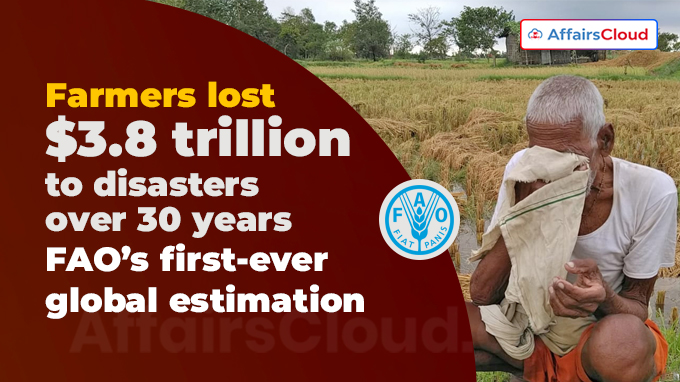 The United Nations Food and Agriculture Organization (FAO) released a report titled ‘The Impact of Disasters on Agriculture and Food Security 2023-Avoiding and reducing losses through investment in resilience‘ which is the first–ever global estimation of the impact of disasters on agricultural production focused on crops and livestock.
The United Nations Food and Agriculture Organization (FAO) released a report titled ‘The Impact of Disasters on Agriculture and Food Security 2023-Avoiding and reducing losses through investment in resilience‘ which is the first–ever global estimation of the impact of disasters on agricultural production focused on crops and livestock.
- As per the report, the Global aggregated losses for the past 30 years (1991-2021) due to disasters events amounts to USD 3.8 trillion, corresponding to about USD 123 billion per year.
- This value is equivalent to 5% of global agricultural Gross Domestic Product (GDP), and nearly 300 million tonnes of accumulated losses per year, or the real GDP of Brazil in year 2022.
- The disaster events include floods, droughts, insect infestations, storms, disease and war.
Who prepared the Report?
The report has been prepared and jointly produced by the Statistics Division (ESS) and the Office of Emergencies and Resilience (OER) of FAO.
Highlights:
i.Between 1991-2021, lower and lower-middle-income countries lost 10% to 15% of their agricultural GDP due to disasters. Small Island Developing States (SIDS) lost nearly 7% of their agricultural GDP.
ii.Major agricultural products faced increasing losses.
- Cereals lost an average of 69 million tons yearly, equal to France’s entire cereal production in 2021.
- Fruits, vegetables, and sugar crops each lost about 40 million tons yearly. For fruits and vegetables, the loss is equivalent to Japan and Vietnam’s entire production of fruits and vegetables in 2021.
- Meats, dairy, and eggs faced a yearly loss of 16 million tons, which corresponds to the production in Mexico and India in 2021.
iii.India’s ban on non-basmati rice exports led to historic low rice availability, causing global prices to rise significantly.
iv.Losses in Asia represented 4% of agricultural added value, while in Africa, it was nearly 8%.
v.High-income, lower-middle-income, and upper-middle-income countries experienced higher absolute losses.
- However, low-income countries, especially SIDS, suffered the most significant losses in agricultural added value.
3 Priorities for Action:
The report outlines three key priorities for action
i.Improve data on disaster impacts in agriculture across all sectors: crops, livestock, fisheries, aquaculture, and forestry.
ii.Developing and mainstreaming multi-hazard disaster risk reduction strategies into policies and programs at all levels.
iii.Invest in resilience to reduce disaster risk, boost agricultural production, and enhance livelihoods.
Key Points:
i.The figure on losses could be higher if systematic data on losses in fisheries, aquaculture, and forestry were available.
ii.Disaster frequency has risen significantly, increasing from 100 events per year in the 1970s to about 400 per year globally in the past 20 years.
iii.In extreme cases, disasters lead to rural population displacement and migration.
Recent Related News:
On 28th June 2023, FAO, United Nations Environment Programme (UNEP), the World Health Organization (WHO) and the World Organisation for Animal Health (WOAH) , “the Quadripartite organisations”, launched “A One Health Priority Research Agenda for Antimicrobial Resistance (AMR)” through a webinar. The Research agenda aims to promote increased research and investment in AMR.
About United Nations Food and Agriculture Organization (FAO):
Director-General– QU Dongyu
Headquarters– Rome, Italy
Establishment– 1945




